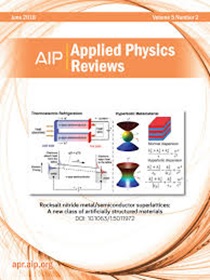光子时间晶体的反常麦克斯韦-加内特理论
IF 11.6
1区 物理与天体物理
Q1 PHYSICS, APPLIED
引用次数: 0
摘要
麦克斯韦-加内特理论可以追溯到詹姆斯·克拉克·麦克斯韦-加内特在1904年的基础工作,它提供了一个简单而强大的框架,将非均匀结构描述为有效的均匀介质,这大大降低了分析、计算和设计的总体复杂性。因此,麦克斯韦-加内特理论在光子学、声学、力学、热力学、材料科学等各个领域都有实际应用。长期以来,人们一直认为麦克斯韦-加内特关于阻抗不匹配周期结构中的光的理论只在长波长范围内有效,这就要求光的时间或空间周期要比结构的时间或空间周期大得多。在这里,我们通过揭示一个反常的麦克斯韦-加内特理论,揭示了超过这个长波长限制的阻抗不匹配光子时间晶体,打破了这个长期持有的信念。这种异常的关键在于法布里-帕姆罗特共振。我们发现,在fabry - p本文章由计算机程序翻译,如有差异,请以英文原文为准。
Anomalous Maxwell-Garnett theory for photonic time crystals
The Maxwell-Garnett theory, dating back to James Clerk Maxwell-Garnett's foundational work in 1904, provides a simple yet powerful framework to describe the inhomogeneous structure as an effective homogeneous medium, which significantly reduces the overall complexity of analysis, calculation, and design. As such, the Maxwell-Garnett theory enables many practical applications in diverse realms, ranging from photonics, acoustics, mechanics, thermodynamics, to materials science. It has long been thought that the Maxwell-Garnett theory of light in impedance-mismatched periodic structures is valid only within the long-wavelength limit, necessitating either the temporal or spatial period of light to be much larger than that of structures. Here, we break this long-held belief by revealing an anomalous Maxwell-Garnett theory for impedance-mismatched photonic time crystals beyond this long-wavelength limit. The key to this anomaly lies in the Fabry–Pérot resonance. We discover that under the Fabry–Pérot resonance, the impedance-mismatched photonic time crystal could be essentially equivalent to a homogeneous temporal slab simultaneously at specific discrete wavelengths, despite the temporal period of these light being comparable to or even much smaller than that of photonic time crystals.
求助全文
通过发布文献求助,成功后即可免费获取论文全文。
去求助
来源期刊

Applied physics reviews
PHYSICS, APPLIED-
CiteScore
22.50
自引率
2.00%
发文量
113
审稿时长
2 months
期刊介绍:
Applied Physics Reviews (APR) is a journal featuring articles on critical topics in experimental or theoretical research in applied physics and applications of physics to other scientific and engineering branches. The publication includes two main types of articles:
Original Research: These articles report on high-quality, novel research studies that are of significant interest to the applied physics community.
Reviews: Review articles in APR can either be authoritative and comprehensive assessments of established areas of applied physics or short, timely reviews of recent advances in established fields or emerging areas of applied physics.
 求助内容:
求助内容: 应助结果提醒方式:
应助结果提醒方式:


